A small town in denial comes face to face with the virus
In late September, before covid-19 swept through southern Illinois like a prairie fire, before nearly every single resident of a nursing home in Du Quoin was infected, before the disease pushed Perry County’s rural health-care system to the breaking point, confidence was in the air.
The county clerk, Beth Lipe, realized the pandemic wasn’t causing any rush for absentee ballots. Of 9,300 applications she mailed out, she got back fewer than 1,000 requests, about the same as any other year.
The staff of the St. Nicholas Brewing Co. on a Friday afternoon set up 10 tables for their evening food and bar service next door in the parking lot of the Du Quoin State Bank. As usual, fewer than half their customers showed up in masks.
Fairview Rehabilitation and Healthcare, on East Jackson Street, had yet to see a single case of covid-19, six months into the pandemic. “I had escaped it,” said the home’s owner, Scott Stout. “We hoped and we prayed.” That month, the U.S. Department of Health and Human Services awarded the nursing home a $19,000 incentive grant recognizing its superior infection-control procedures, one of thousands of such grants across the nation.
Elsewhere in the United States, the death toll passed 200,000. But up at the north end of Washington Street, the nurses at Marshall Browning Hospital, a 25-bed “critical access” facility, were beginning to exhale because there had been so few signs of the illness since a brief flurry in the spring.
“We had a really long grace period,” said Amy Blakemore, the medical-surgical nurse manager at the hospital. “I’m going to attribute it to sheer dumb luck that we kept our numbers as low as we did as long as we did.”
 Amy Blakemore, medical-surgical nurse manager at Marshall Browning Hospital, said it was “sheer dumb luck that we kept our numbers as low as we did as long as we did.” (Whitney Curtis for The Washington Post)
Amy Blakemore, medical-surgical nurse manager at Marshall Browning Hospital, said it was “sheer dumb luck that we kept our numbers as low as we did as long as we did.” (Whitney Curtis for The Washington Post) Du Quoin’s experience with covid-19 this past fall was typical of hundreds of small towns across the United States. Alarm when the pandemic began gave way to a mixture of complacency, denial and resistance to public health measures as the disease seemed for so long to be passing rural America by.
“We’re prone to that make-believe way of thinking,” Blakemore said. “It’s not going to happen here. It’s a city thing.”
[Sen. Warren calls Genesis Healthcare executive bonus act of ‘unfathomable greed’]
But when it became real, spreading across the Midwest, filling hospitals to capacity, many nursing homes found that good infection control on paper was no match for an insidiously contagious virus. The inspection system for American nursing homes left them ill-equipped to deal with the novel coronavirus and, in far too many cases, blind to the threat. At the moment of crisis, a lack of hospital space forced nursing home staffers to take on the burden of covid-19 care — an obligation many shouldered with heroic dedication, but lacked proper equipment and training to fulfill.
What happened at the Fairview Rehabilitation and Healthcare center, where the coronavirus infected 42 residents and killed a quarter of them, was not an exception. Resthaven Nursing and Rehabilitation in Lake Charles, La., had no cases in September, October or November, then nearly 100 in three weeks in December. Elderwood in Hamburg, N.Y., had none through early December, and then 48 in the month that followed. Windber Woods in Paint, Pa., had none through late November, then 45 over the next six weeks. Parke View Rehabilitation and Care Center in Burley Falls, Idaho, had three cases in all of last year, and 24 this year.
Each of those nursing homes received incentive grants from HHS in the fall for good infection control, ranging from $34,000 to $69,000.
In Perry County, there had been just one death all spring, a 58-year-old long-haul trucker who was joking with nurses when he showed up at the emergency room. A few hours later, he was on a ventilator, and not long after that, he died.
Health-care workers and nursing home staffers and administrators understood the need for vigilance. Du Quoin Mayor Guy Alongi urged residents to adhere to national and state guidelines. The Perry County fair was canceled for the first time since 1856, then the late-summer Du Quoin State Fair was, too.
But Perry County, about 80 miles southeast of St. Louis, is a deeply conservative place. President Donald Trump received 72 percent of the 2020 vote there, and a steady diet of contrarian attacks on mask-wearing and social distancing on TV and in social media, in the name of liberty, had an effect.
Alongi, whose family has run a restaurant in Du Quoin since 1933, said residents had asked him to somehow countermand an Oct. 19 order by Gov. J.B. Pritzker (D) reimposing a ban on indoor seating at dining establishments.
 Mayor Guy Alongi stands for a portrait in the Du Quoin City Council chambers. When positivity rates shot upward in the fall, he said it was like being hit with a ball-peen hammer. (Whitney Curtis for The Washington Post)
Mayor Guy Alongi stands for a portrait in the Du Quoin City Council chambers. When positivity rates shot upward in the fall, he said it was like being hit with a ball-peen hammer. (Whitney Curtis for The Washington Post) That the disease had not made a real appearance there, that it was still an abstraction, sharpened residents’ skepticism.
But November’s eruption illuminated a deeper, underlying small-town problem. Marshall Browning Hospital has no intensive care nurses. The nearest ICU is 25 miles away, at Memorial Hospital of Carbondale, and when that fills up, patients are looking at a two- or three-hour ambulance ride to the nearest ICU. After the Carbondale hospital was out of space, as it would be in November, the best options were in Missouri, Indiana or Kentucky.
[Profit and pain: How California’s largest nursing home chain amassed millions]
During quiet month, warning signs
In Collinsville, a suburb of St. Louis on the Illinois side of the Mississippi, Edythe Walston was admitted to the hospital with pneumonia. It was Sept. 15.
Divorced when her three children were still small, she had a long career as an administrative assistant at the Peabody Coal Co., followed by a few years as a laboratory administrator in St. Louis.
Walston lived alone in the old family house in Collinsville, tending to her vegetable garden, caring for her cats and volunteering at the local pet rescue organization. She had been a conscientious newspaper reader all her life, but by now she was 85, suffering from heart disease and showing signs of mild dementia. All summer, she had been having recurring bouts of pneumonia, and in September it flared up again.
The hospital stabilized her and, with the pandemic putting pressure on all the hospitals in the St. Louis metropolitan area, sent her by cab to a local nursing home two days later.
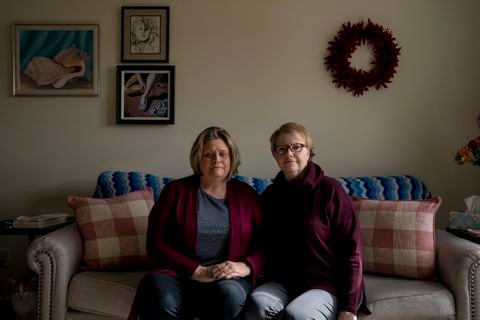 Vicki Short, left, and her wife, Jess Short, at their home in De Soto, Ill. Vicki’s mother, Edythe Walston, died of covid-19 during an outbreak at Fairview Rehabilitation and Healthcare center in November. (Whitney Curtis for The Washington Post)
Vicki Short, left, and her wife, Jess Short, at their home in De Soto, Ill. Vicki’s mother, Edythe Walston, died of covid-19 during an outbreak at Fairview Rehabilitation and Healthcare center in November. (Whitney Curtis for The Washington Post) Walston’s daughter, Vicki Short, drove up as soon as she could from her home near Carbondale. Short, who is 52, had been living in Madison, Wis., but moved back with her wife, Jess, to Illinois so she could be closer to her mother.
Walston was too feeble to go home, but Short was deeply disturbed by the conditions she found at the nursing home. “It felt like a warehouse,” she said. Worse, her mother had been hurt in a fall the day after she was admitted. Short resolved to find a place closer to where she and Jess lived.
On Sept. 26, an ambulance took her to the Fairview nursing home, a one-story brick building in Du Quoin across the street from a company that manufactures commercial holiday decor. There, about a 90-minute drive from the St. Louis metropolitan area where Walston had lived and worked, Short hoped the staff would have the time to do what they could to make her mother’s life as meaningful as possible. As she was about to be wheeled in, Short gave her a hug. It was their last.
Walston was placed in a two-week quarantine. A coronavirus test came back negative. In a small town in the heart of the country, she and her daughter were outsiders.
[In a relentless pandemic, nursing-home workers are worn down and stressed out]
On the surface, October was another quiet month. Fairview kept the virus at bay and federal regulators awarded it another incentive grant for quality infection control, this time for $48,000.
But all along there had been warning signs, some more obvious than others. A nursing home about 13 miles away, also operated by Stout’s company, had 46 confirmed cases and three deaths during an outbreak in August. Stout said he and the staff at his firm, WLC Management, ran through many scenarios to think through how to avoid a repeat occurrence.
Handling a pandemic was a dire responsibility. Stout said he was frustrated by the constantly changing advice from federal and state health agencies. “You got to juggle all these guidelines,” he said. “I told everybody, ‘Give us the playbook. Tell me exactly what we need to do, and we’ll do it.’ ”
Stout, 49, studied to be a mortician before he went into the nursing home business, and also owns a bar-and-grill. WLC operates 11 nursing homes and one assisted-living center in southern Illinois, and they get high marks from the Centers for Medicare and Medicaid Services (CMS), the federal agency that regulates nursing homes. Fairview has four stars, out of a possible five.
 At Fairview Rehabilitation and Healthcare center, nearly every resident tested positive for the coronavirus in November. (Whitney Curtis for The Washington Post)
At Fairview Rehabilitation and Healthcare center, nearly every resident tested positive for the coronavirus in November. (Whitney Curtis for The Washington Post) Yet a deeper dive into the reports compiled on every nursing home in the United States shows that in 2019, Fairview rehabilitation patients were 20 percent more likely than the average to return to the hospital for treatment, and were more than four times as likely to be treated with antipsychotic medications. Long-stay residents were almost twice as likely to require emergency room visits, and three times as likely to have urinary tract infections.
Stout said these figures are misleading: “They don’t give you the full picture.”
Blakemore, the nurse manager at Marshall Browning Hospital, said she believes that nursing home residents in her part of the state are generally in worse health than elsewhere to start with, because this is the sort of rural community where families “turn themselves inside out” to care for the elderly at home as long as possible. “By the time families are ready to concede this is more than they can do,” she said, “those residents are really on the downhill slide.”
Optimism prevailed, but virus crept in
Throughout October and into November, Vicki and Jess Short went to Fairview and visited with Walston as best they could, sitting outside a window on a bench and using a baby monitor to talk. Walston was getting confused, and Vicki Short could see that the edema she suffered in her legs was getting worse because they weren’t properly propped up. “We just tried to keep her spirits up,” Vicki Short said. “It sucked.”
Some of the staffers were thoughtful and caring, she said, but others seemed to show “a lack of empathy or compassion, or they’re all just horribly burned out.”
On Oct. 11, state health officials held a Zoom call with local officeholders in southern Illinois, telling them the positivity rate for coronavirus tests in their region was growing fast, reaching 7.3 percent.
It had an effect. “Finally the ball-peen hammer hit the head and knocked some sense into it,” said Alongi, the Du Quoin mayor, “and people masked up.”
[How government incentives shaped the nursing home business — and left it vulnerable to a pandemic]
Three days later, the Perry County Board of Health renewed a discussion from summer about priorities for spending an $800,000 contact-tracing grant from the state.
November was calm to start with. Election Day came and went. Perry County turnout was strong, and in person, and Trump clobbered Joe Biden throughout most of southern Illinois.
 Main Street in Du Quoin was quieter than usual after indoor dining was banned in October. (Whitney Curtis for The Washington Post)
Main Street in Du Quoin was quieter than usual after indoor dining was banned in October. (Whitney Curtis for The Washington Post) While voters were at the polls Nov. 3, Fairview tested all of its staffers for the coronavirus. Two days later, the results came back: all negative. The nursing home, locked down since spring, sent out a text message to families (which Short shared with The Post): “The positivity rate continues to climb in our region. We are monitoring it daily and will adjust our testing schedule as required. We are working on plans to reopen for visits and will notify you as soon as this is allowed.”
The optimism turned out to be misplaced.
Staff tests were stepped up to twice a week. On Nov. 12 came word that one employee had tested positive. A text message assured families, “We will continue to test twice a week, Tuesday and Friday, until we have two weeks of negative testing. Until further notice, all dining and activities will be done in the resident rooms.”
But there was no stopping it.
“All it needed was that one little crack to get in there,” Blakemore said. “And then it was like gasoline on a brush fire.”
Five residents tested positive on the 13th, the first since the pandemic began, according to Fairview’s text messages. Nine more were added on the 17th, four more on the 19th, plus four employees. As symptoms began to show, staffers created an isolation wing for the ill, but the virus stayed ahead of them. In that first week, Fairview reported 18 resident cases to CMS, 22 more the next week, a total of 42 by early December.
All but a very few residents, in other words, showed signs of the coronavirus. Eventually, at least 11 would die of the disease.
“I was at Fairview when the breakout happened,” Stout said. “We were heartbroken because we hoped it wouldn’t get in the building. But the virus started spreading so quick.” His staff followed proper procedures when moving residents, he said. “We put a face mask on them and we gowned them up.”
After that first text message from Fairview about a positive test result, Vicki Short said, “we’re thinking, okay, she’s in a room alone, she’s asymptomatic, she’s got a fighting chance here.”
But as the next few days went by, Short learned her mother had picked up a cough. Short couldn’t visit because of the lockdown, so she couldn’t see what was happening.
Her mother was lethargic and had trouble getting her words out when Short called her. A coronavirus test on Nov. 23 came back positive. A health coordinator called Short a day later: Her mother was in trouble. There was no room at Marshall Browning Hospital. Walston was turning blue from a lack of oxygen. Another call: A bed had just opened up at the hospital.
Blakemore had the “hard conversation” with Short when her mother was admitted. “I just remember telling her that we were going to take good care of her and keep her comfortable,” Blakemore said. “Her mom was really, really sick. I remember it being really sad. It’s just a really heartbreaking thing to know there’s nothing you can do for them.”
Edythe Walston died at 6:12 the next morning.
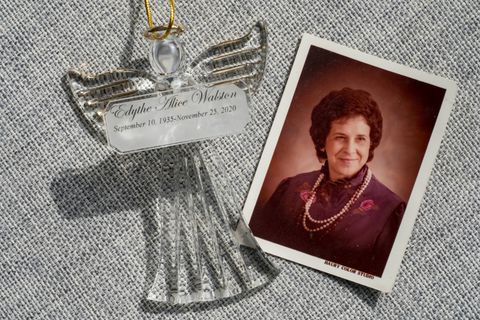 An angel Vicki Short received from the funeral home is seen with a photo of her mother, Edythe Walston, at her home in De Soto. (Whitney Curtis for The Washington Post)
An angel Vicki Short received from the funeral home is seen with a photo of her mother, Edythe Walston, at her home in De Soto. (Whitney Curtis for The Washington Post) “Mom was very strong-willed, like people of her generation,” Short said. To see her go that way, cut off and alone, no hugs or kisses, has left a hole, for her and Jess both.
“It’s amazing how life throws things at you, and you go down a path you didn’t intend. Love is love. We didn’t plan on losing Mom so quickly. We’re kind of like an open book and the chapter hasn’t been written yet.”
[Task force says nursing homes need more aid. Critics say industry should step up.]
‘A sense of failure’
All these weeks, Blakemore, 52, had been managing the nursing staff of about 40 at the hospital. Covid-19 victims “would come to our ER and we couldn’t get them transferred anywhere, because all the ICU beds were full,” she said. “You’re asking us to do ICU stuff, and we’re [medical-surgical] nurses. We did a lot of education on the fly. There’s no evidence-based practice for this, so we were making it up as we went along. Everybody in rural health care was probably in the same boat.”
The advantage of a small town, she said, is that everybody knows everybody, and a lot of people pulled together to try to get through the crisis. At the two nursing homes in Du Quoin (the other one is also a WLC property, next door to Fairview and also stricken by the virus), staff knew they’d have to care in place for patients who would normally be sent to the hospital. There were calls back and forth, asking for advice, asking for help. Blakemore sent hospital nurses to the nursing homes to assist in setting up intravenous lines.
“It was just an intense time,” she said. “The numbers at our nursing homes were very sadly so high. We had kept it out so long. It was almost a sense of failure when it got there. It was a team effort to dig out of that hole.”
She could sense that her staff was starting to dread coming to work, afraid of doing the wrong thing. “These are good-hearted people,” said Blakemore. “They were worried they wouldn’t be up to the challenge of it. It took a lot of coaching and almost mom-cheerleading: ‘We’re going to get through this together. It’s not going to be easy.’ ”
Anand Patel, a physician who had experience in ICUs, was a “godsend,” she said, helping the staff work their way through the challenges.
On her way home, she’d sometimes stop off at Walmart and be shocked to see so many customers without masks. “You don’t understand,” she’d think. “This is a whole different animal. You think you’ve got a handle on it, and then it explodes like a nuclear bomb.”
When the month began, Perry County, population 20,000, had experienced fewer than 500 coronavirus cases over seven months, according to the Illinois Department of Public Health. By Nov. 12, when word came of the first positive test at Fairview, the county had 653 cases. By the end of the month, 1,238. By the end of January, 2,940, or nearly 15 percent of the county’s residents. That’s almost double the percentage of New York City’s caseload. Fifty-six have died.
The hospital stepped up its efforts to communicate with the town through its Facebook page, emphasizing masks, hand-washing and social distancing. “There are just some people you cannot convince,” said Pam Logan, who runs the page. And, she added, they won’t listen until someone in their family gets seriously ill.
Blakemore’s great-grandmother, Ella McMurtrie, was the first formally trained nurse at a community hospital in Sparta, Ill. During the 1918 flu epidemic, she knocked on doors, asking residents about symptoms, urging them to wear masks, to stay home. She visited the homes of Black families who either wouldn’t, or more likely couldn’t, be treated at the hospital.
 Amy Blakemore, medical-surgical nurse manager at Marshall Browning Hospital in Du Quoin, holds a portrait of her great-grandmother, Ella McMurtrie, who was a nurse during the 1918 flu epidemic. (Whitney Curtis for The Washington Post)
Amy Blakemore, medical-surgical nurse manager at Marshall Browning Hospital in Du Quoin, holds a portrait of her great-grandmother, Ella McMurtrie, who was a nurse during the 1918 flu epidemic. (Whitney Curtis for The Washington Post) “I guess door-to-door is what you did before Facebook,” Blakemore said.
She keeps a portrait of McMurtrie on her wall. “Judging me. Every time I get frustrated, I look up at her, and I go, ‘Okay, fine. Okay, fine, Gram.’ ”
[Nursing homes say they ‘treat in place.’ Then came covid-19.]
Stout said he doesn’t know what else his staff at Fairview could have done. “This virus, I don’t think anybody really knows how it spreads,” he said. (The Centers for Disease Control and Prevention says the virus is primarily spread through airborne droplets.)
He’s angry at the criticism nursing homes have received. “I haven’t been in a real festive mood. I care about my staff, my team members. I care about my residents. The sad thing, everybody wants to talk negative about long-term care. We get up every day and fight the good fight. We’ve stayed on top of it. But all everybody wants to do is come in and scrutinize us.”
The people who work for him can’t cut themselves off from the community, he said. They still have to go to the store, and they can’t help mingling there with people who don’t wear masks. They can’t eliminate the risk of exposure. By the end of the outbreak, 18 staffers had tested positive.
And unlike other kinds of businesses, a nursing home can’t shut down. “My staff never got a break,” he said. “This isn’t an easy job. You couldn’t go to your house and hide and sit at your computer and look out the window.”
He said he is proud of the way his staff responded. “You think I haven’t asked myself a million times what I could have done different? You think I haven’t had sleepless nights? Everybody makes mistakes, but we’ve been doing everything we could think of doing.”
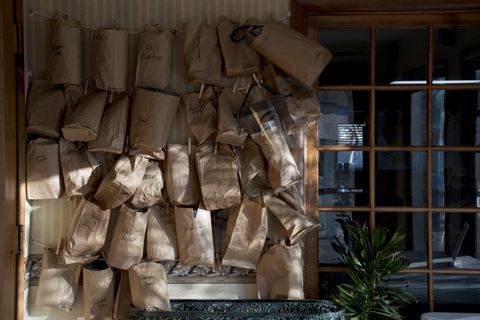 Paper bags filled with employees’ personal protective equipment hang in the entranceway to Fairview Rehabilitation and Healthcare center. (Whitney Curtis for The Washington Post)
Paper bags filled with employees’ personal protective equipment hang in the entranceway to Fairview Rehabilitation and Healthcare center. (Whitney Curtis for The Washington Post) Barbara Stevenson, the administrator of the Perry County Health Department, said she thought the staff at Fairview and other local nursing homes did as well as they could, given the realities they were facing: close quarters in the facilities and a high positivity rate in the city and county. Residents at high risk because of their underlying health are going to have a high death rate, she said.
“These are things you honestly can’t fix,” she said. “I guess if we had found a strategy that helped, I definitely would have been asking for it.”
Vicki and Jess Short both came down with covid-19 in December, just as the outbreak was waning in Perry County, but have slowly recovered. Vicki is grieving and angry. Grieving at the way her mother, stubborn and self-sufficient all her life, spent her last confusing, unhappy days. Angry because she believes she wasn’t getting a full picture from Fairview as to what was happening. “We couldn’t get any answers. How do they do infection control? Just to not even have that transparency is scary and awful.”
Angry, too, because it seemed that state and national health officials had done little through the 10 months of the pandemic to get a better handle on nursing home practices. “They basically throw their hands up and say, ‘It’s very contagious. It’s a tragedy.’ It’s a very piecemeal, hodgepodge, ridiculous system, especially in rural counties. What are you guys doing to learn from the tragedy that happened to my mom?”
A consultant with the Illinois Department of Public Health, Deborah Burdsall, said the nursing homes that have had the best results in keeping the coronavirus out were those that jumped into high gear at the first sign of infection. The pandemic, she said, “had driven home the need for comprehensive infection prevention and control in long-term care facilities, and it will happen.”
Stout is angry because he says he needs more staff, but it’s nearly impossible to hire anyone. He estimates that 35 percent of his 650 employees companywide left in 2020. He blames enhanced unemployment insurance. “This day and age, the government’s gone too easy on handouts, and no one wants to work,” he said.
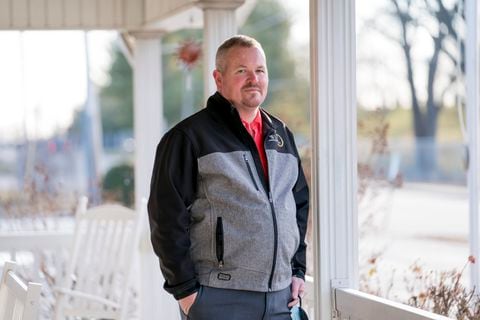 Scott Stout, CEO of WLC Management, standing on the porch of Fairview Rehabilitation and Healthcare center in Du Quoin, complains that he has trouble recruiting staff. (Whitney Curtis for The Washington Post)
Scott Stout, CEO of WLC Management, standing on the porch of Fairview Rehabilitation and Healthcare center in Du Quoin, complains that he has trouble recruiting staff. (Whitney Curtis for The Washington Post) “I wish somebody in the Biden administration would call me and ask me about my work, day in and day out,” he said. “Every day of our lives. We are dedicated.”
At the St. Nicholas Brewing Co., diners are seated inside now that the positivity rate has declined, at widely spaced tables. General manager Abby Ancell, who pioneered farm-to-table dining in Du Quoin, is especially proud of the fish tacos. People still show up without masks; the restaurant has a stash by the door for patrons to wear while they walk to their tables. Some roll their eyes. Others turn on their heels and walk out. “Small-town southern Illinois, you never know what you’re going to get,” Ancell said.
“A lot of people think it’s over,” said Dan Eaves, the head of Marshall Browning Hospital. “We still have churches that are allowing people to come without masks. It’s very disappointing.”
Blakemore is wary. “We could easily have another November if we don’t maintain the caution and follow the guidelines and listen to the science,” she said. Du Quoin can’t go back to the reckless and complacent way things were last summer, she said, “where everybody says, let’s take a big, deep breath, let’s go about our lives, let’s rip our masks off, or go on a vacation, or let’s have a prom, or let’s have a party, or let’s have a wedding with 400 guests. Getting people to understand that it’s not time yet — that’s the biggest challenge.”
And if people don’t listen, and the disease erupts again even as vaccinations are starting?
“When it’s time to start bailing water,” Blakemore said, “we start bailing water.”
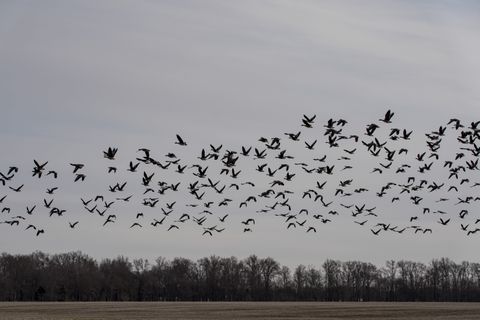 Geese fly over a field in Du Quoin. (Whitney Curtis for The Washington Post)
Geese fly over a field in Du Quoin. (Whitney Curtis for The Washington Post) 





